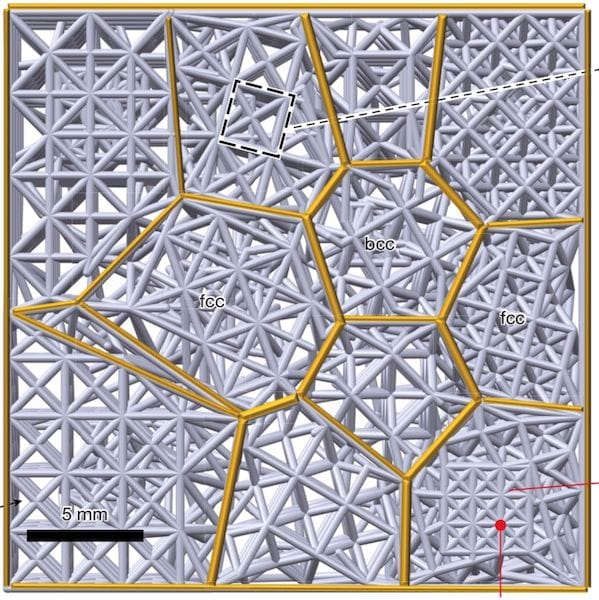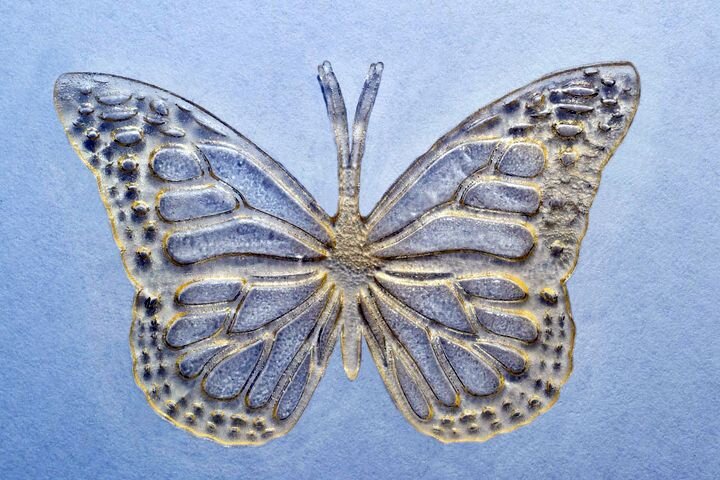![3D printed metacrystals can increase part strength [Source: Chen Liu and Minh-Son Pham/Imperial College London/Nature]](https://fabbaloo.com/wp-content/uploads/2020/05/image-asset_img_5eb09e0895021.jpg)
Researchers at Imperial College London and the University of Sheffield have developed a powerful technique to strengthen metal 3D prints.
The key advantage that’s most often used in industry when 3D printing metal objects is to use a lattice structure to lose weight on the component. This is of particular interest to aerospace applications where, well, weight really counts.
The weight loss through lattices is frequently used, but there is an inherent problem with lattice structures. By definition they are “regular”, in that a simple pattern of nodes is repeated throughout the structure. While this does eliminate a substantial amount of material, it introduces new ways for the component to fail.
A regular lattice would eventually fail along “lines” through the structure, as seen in this image:
![Typical 3D printed lattice breaking along a “fault line” [Source: Nature]](https://fabbaloo.com/wp-content/uploads/2020/05/image-asset_img_5eb09e08e7d13.jpg)
This is okay if the strength required for the part is less than the breakage level. But what if you needed a part that is even stronger, so strong that you might lose the advantage of the lattice weight-loss program?
The usual answer would be to simply add more material. This could be done by thickening the node paths, or perhaps even eliminating the lattice entirely. But those approaches defeats the goal of weight loss.
Now these researchers have taken a page from nature (and, by coincidence, published their findings in Nature). They realized that some natural materials are stronger due to their differentiated crystalline structure.
A pure crystal is in fact a kind of lattice, which would be subject to the same phenomenon as described above. But what if the material wasn’t “crystal” but instead was “crystals”?
Take a careful look at the top image, where you can see a representation of what they devised. Here you see lattice structures – many of them. But each group of lattices is disoriented from others. There are “boundaries” between them, but the result is a highly irregular clump of lattices that still maintain weight goals.
However, think about how mechanical stresses might be taken on by such a structure. If the stress’ direction is non-optimal for one lattice group, it would not be for the next group, and the next one. It’s almost like having a lattice that goes in every possible direction. This is the ideal way to generate strong lattices.
We do know that many researchers are attempting to strengthen metal 3D prints by reorganizing the microscopic crystalline structure through chemical and thermal approaches, but this is quite different. It is like making crystals at a macro scale.
That all said, it would appear that this could be a relatively easy feature to add to a 3D CAD tool. Many CAD tools today are capable of automatically generating lattice structures, and it should be easy to tweak them to generate randomized groups of lattices to create incredibly strong designs.
While the researchers focused on metal applications, there is no reason to not use a similar technique for polymer objects: mechanical stress is mechanical stress.
However, the technique is likely patented or otherwise owned, so there may be some licensing fees owed by anyone attempting to duplicate this approach.
Via Imperial College London and Nature











A research thesis details the incredibly complex world of volumetric 3D printing. We review the highlights.